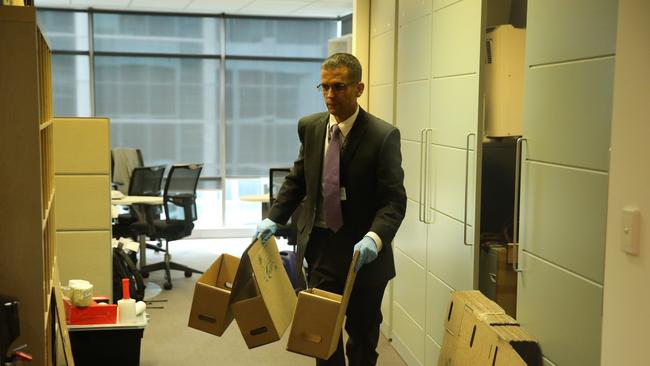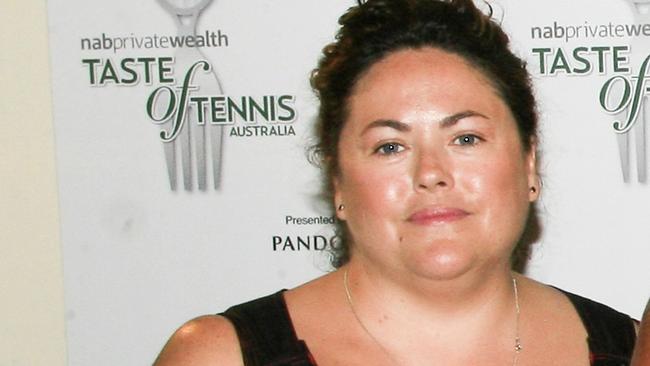Breach of trust: mystery surrounds NAB scandal
Unbeknown to anyone except the perpetrators, NAB had been in the grip of an extraordinary scandal for years.

Helen Rosamond, a well-groomed English woman with short dark hair and an attractive open smile, arrived at the modernist 32-storey skyscraper, home to National Australia Bank, on Sydney’s George St. She took the elevator to level 28 where she met Rosemary Rogers, a top bank executive with the keys to the kingdom, who wielded power with unflinching force.
Rosamond and Rogers had met many times, negotiating lucrative contracts for Rosamond’s company to organise big events for the bank. It was one small part of Rosemary Rogers’ sweeping remit at NAB — from executive appointments to approving multi-million-dollar contracts. She held the secrets of the inner sanctum. She travelled regularly back and forth from the bank’s Docklands Melbourne headquarters to the Sydney office. She was the trusted chief of staff to NAB chief executive Andrew Thorburn — just as she was to the CEO before him, Cameron Clyne. With the trust vested in her, Rogers’ influence reached throughout the bank.
Suddenly, around December 13 last year, Rogers was called in from holidays in Victoria for a meeting with Thorburn at Docklands. By the end of that meeting she had resigned. There had been a serious error of judgment. Rogers and Rosamond would never again meet on the bank’s premises.
Unbeknown to anyone except the perpetrators, NAB had been in the grip of an extraordinary scandal for years. No one had seen it happen — until a stunning whistleblower complaint in early December last year exploded inside the bank like a bomb on a summer’s day.
Five months later, on April 10, detectives from the NSW financial crimes squad simultaneously raided two business addresses in North Sydney and Milsons Point, as well as the rented inner-city Potts Point home of Helen Rosamond, seizing boxes of documents and electronic devices.
The financial crimes squad commander, Detective Superintendent Linda Howlett — a former commander of the sex crimes squad — announced police were investigating a multi-million-dollar corporate fraud and the payments of corrupt commissions — illegal kickbacks — for contracts from a financial institution. That institution was NAB, one of Australia’s biggest banks, and the fraud allegations circled both Rosemary Rogers and Helen Rosamond.
Howlett told journalists that the police corporate corruption team was tracking payments and other funds to determine whether an offence had been committed. It was alleged that inflated invoices from an external contractor were authorised by a person who received commissions or kickbacks from the deals.
Howlett said last week the alleged crimes could lead to lengthy imprisonment.
“I can’t speculate on charges, but generally speaking many fraud offences have a maximum penalty of 10 years imprisonment.”
With no charges laid, and all of the matters still under investigation by police, the origins of the scam to defraud NAB remain opaque. How the alleged offences began has not come to light. Nothing has been proven, no wrongdoing on the part of either woman has been established and neither woman has spoken publicly.
But the psychology of the relationship between Rogers and Rosamond has attracted considerable speculation.
For Andrew Thorburn, the exposure for the bank and the horror of his own chief of staff allegedly caught up — right under his nose — has been devastating. The CEO’s distress about the failure of trust in — and the impact on — those he was close to was obvious in his press conference; after all, a CEO is rarely closer to anyone than his executive assistant and chief of staff.

But to many others at NAB, Rosemary Rogers was a polarising and widely disliked figure. She had worked for the bank for years and had been EA to chief executive John Stewart and then to his successor, Clyne, who made her chief of staff as well.
Some NAB insiders claim Rogers ruthlessly used her proximity to the CEO; she was described as overbearing and capable of running vendettas against both senior managers and lowly administrative staff. Her role in managing relationships within the bank’s executive recruitment process was a feared power. When there was a vacancy on the executive team, it was Rogers who ran the process. She had the ear of the CEO; she was alleged to have stoked anxiety by casting doubt on the performance of some executives while energising others. She enjoyed remarkable power and responsibility, bestowed from the top. In December, it was alleged that she had abused all of this.
When Thorburn arrived as CEO, bank insiders claim a recommendation was made by another senior executive to remove Rogers from the chief of staff role. But Rogers also had her supporters, among them the outgoing Clyne. Thorburn kept her on.
Rogers’ desk was originally so close to Thorburn’s in a communal desk pod that she could speak to him without lifting her voice. Rogers had a payment delegation authority in the millions of dollars, enabling her to authorise contracts at a high level.
The risk and audit controls around NAB’s event management contracts have now come under scrutiny — with contracts handled by Rogers allegedly run outside normal constraints.
Whether her position in the closest circle of the boss eliminated Rogers from layers of audit is unknown. Appropriate internal audit and risk controls would have assessed why contracts were of a certain size, what the bank expected from them, and why the same expensive contractor was used over and over again. These matters were only raised, finally, by a whistleblower before Christmas.
Once that complaint came in, the bank commenced its own investigation with an internal forensic team deployed to access records without alerting suspicion. NAB, like all banks, has a financial crime team and forensic former police on staff.
In the aftermath of her resignation, Rosemary Rogers’ computers, emails, phone records and any other documents and material remained with the company by law. She had also banked with NAB.
If there was any criminal conduct at NAB, then the questions revolve around not just how such a scam began, but how it was kept going. How did those involved open the scam in the first place, without one interested party tipping off authorities about the proposals of another? And how it was able to continue for up to a decade? Did it start with an accidental overpayment? Was there friendship that turned into corruption? Was there simply tempting opportunity? And how was it that the most basic risk and audit structures were not in place, with contracts with the same contractor running one into the next?
After examining all of the internal and available records in Melbourne, the bank called in the NSW police in the first week of February. The bank itself kept digging. The NAB board was understood to be made aware of the complaint and investigation early on.

Operation Napthali was formed by the police corporation corruption team. After examining material handed over by NAB’s investigators, police resolved to search premises associated with Rosamond. The time was set for just after 9am on a Tuesday; the businesses — Rosamond’s Human Group in North Sydney and also an accountant’s office in Milsons Point — needed to be open. With the search warrants an evidence-gathering exercise, police wanted people on the premises.
Three teams of police made their way to the three locations — the third being Rosamond’s home address. Police at each venue included a small team of investigators, the warrant holder, and a uniformed independent officer. There was no forced entry. At North Sydney, police took all day sifting evidence.
Regulators were informed when the police raids took place.
For the bank, in terms of imagery around the raids, there was an emotional CEO, dealing with shock and broken trust. And there was devastating video TV footage of detectives in pale blue rubber gloves sorting through NAB documents and other financial material in the offices of a contractor who for years had walked up the steps in George St, in through the glass and marble foyer, and then whisked straight up by elevator to the NAB’s executive floor.
Since the police raids, journalists have pieced together information on large property portfolios held by both Rosamond and Rogers. The photo spreads show handsome homes valued in the millions of dollars. Rogers was a well-paid executive on an estimated $500,000 a year. Rosamond ran a business that is hard to trace online — with only a handle of mentions and none of the big presence that events companies usually assemble as part of their digital promotion.
Neither woman has been seen publicly since. The rented home of Rosamond in Potts Point, a wealthier version of the raffish but stylish St Kilda in Melbourne, was in darkness for a day, with the exception of a sad-looking golden-haired dog peering through the terrace bars. Since then an older couple has come and gone in a small car and the front door has often stood open, the dog looking out from a front window.
At NAB, already in the teeth of a royal commission into the activities and risk controls of all major banks, an internal fraud scandal, laced with the personalities of the executive suite could hardly be less welcome.
For Andrew Thorburn and the NAB board, the pain veers between trying to grasp the debacle of how the risk controls cracked, and trying to see through the mirror. “I’m hurt because there are people here who are alleged to have been involved that I know who they are and — particularly in one case — I’ve had a longstanding personal relationship,” Thorburn said.
Which of course is one reason audit and risk are there in the first place: to level the playing field.




To join the conversation, please log in. Don't have an account? Register
Join the conversation, you are commenting as Logout